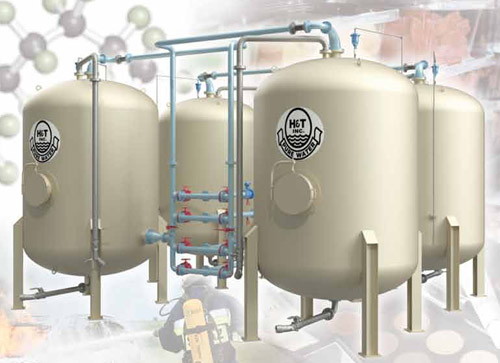PFAS Waste Management in Industrial Operations to Minimize Environmental Harm
Wiki Article
Cutting-edge PFAS Treatment Solutions for Safer Water
The increasing frequency of PFAS contamination in water supplies demands an essential evaluation of cutting-edge treatment remedies. Advanced filtering technologies and unique chemical treatments existing promising opportunities for minimizing these relentless pollutants. Furthermore, arising bioremediation techniques use a more lasting approach to tackling PFAS obstacles. As regulative structures remain to adapt, recognizing the performance and scalability of these options comes to be vital. What ramifications do these innovations hold for public health and wellness and environmental remediation, and exactly how can stakeholders efficiently apply them in varied contexts?Summary of PFAS Contamination
PFAS contamination has arised as a substantial ecological and public wellness problem. Per- and polyfluoroalkyl materials (PFAS) are a team of artificial chemicals recognized for their perseverance in the setting and body, leading them to be generally described as "for life chemicals." These substances have actually been commonly utilized in different industries, including firefighting foams, water-repellent fabrics, and food product packaging, largely as a result of their water- and grease-resistant residential properties.The widespread usage of PFAS has actually led to their discovery in soil, water supplies, and even in the blood of humans and animals. Studies have linked PFAS exposure to countless wellness concerns, including developing impacts in babies, body immune system disorder, and various types of cancer. Furthermore, the environmental determination of these compounds complicates their destruction and elimination, raising problems regarding long-term eco-friendly effects.
Regulatory bodies are significantly carrying out strict standards to keep an eye on and decrease PFAS degrees in alcohol consumption water and other ecological mediums. As recognition of PFAS contamination grows, it has actually ended up being necessary for communities and sectors to seek reliable treatment solutions to alleviate exposure and secure public health.
Advanced Purification Technologies
As the urgency to attend to PFAS contamination magnifies, progressed filtration modern technologies have become a pivotal element in the removal efforts targeted at removing these consistent chemicals from water resources. These innovations leverage advanced mechanisms to successfully target and record PFAS compounds, which are infamously immune to traditional therapy methods.Among the most encouraging strategies is making use of granular activated carbon (GAC), which adsorbs PFAS molecules because of its high area and porous framework. This approach has actually been commonly carried out in both local and commercial setups, showing substantial decreases in PFAS focus. In addition, ion exchange resins have acquired traction, particularly created to uniquely bind PFAS ions from water, hence promoting their removal.
Membrane filtration innovations, such as reverse osmosis and nanofiltration, likewise reveal effectiveness in PFAS elimination by literally separating pollutants from water - pfas management. These systems can accomplish high degrees of purity, making them suitable for drinking water applications
Chemical Treatment Innovations
Various chemical treatment innovations are being explored to effectively deal with PFAS contamination in water supplies. One promising approach entails making use of sophisticated oxidation processes (AOPs), which utilize effective oxidants such as ozone, hydrogen peroxide, or chlorine dioxide incorporated with UV light to damage down PFAS compounds into less harmful materials. This approach has actually demonstrated effectiveness in research laboratory settings, revealing prospective for scalability in real-world applications.Another innovative approach is the growth of ion-exchange resins specifically designed to target PFAS. These materials can uniquely adsorb PFAS substances from water, permitting their removal throughout treatment processes. Current improvements have boosted the effectiveness and capacity of these materials, making them a desirable option for water therapy facilities.
Additionally, scientists are examining making use of chemical representatives like persulfate and ferrous ions to enhance the destruction of PFAS in polluted water. These agents can cause chemical reactions that facilitate the malfunction of persistent PFAS substances.
Arising Bioremediation Techniques
Current improvements in chemical therapy developments have m270 waste management actually led the way for exploring bioremediation strategies as a viable choice for dealing with PFAS contamination. Bioremediation uses the natural metabolic procedures of microbes to degrade or change pollutants, making it an enticing strategy for dealing with consistent impurities like PFAS.
Emerging methods in bioremediation consist of using genetically engineered microbes that can specifically target and break down PFAS substances. These microbial pressures are being developed for their improved destruction capabilities, increasing the performance of the remediation procedure. Furthermore, scientists are investigating the possibility of plant-assisted bioremediation, where particular plant varieties may uptake and withdraw PFAS from contaminated soil and water.
One more encouraging strategy is the application of bioaugmentation, which involves introducing helpful microbes into contaminated environments to improve the deterioration of PFAS. This technique can assist in much faster removal timelines and boost total effectiveness.

Regulative Frameworks and Specifications
A thorough governing structure is essential for effectively managing PFAS contamination and guaranteeing public wellness protection. The increasing recognition of per- and polyfluoroalkyl substances (PFAS) as environmental pollutants has motivated numerous government and state firms to establish requirements that regulate their visibility in water products. The U.S. Environmental Security Company (EPA) has actually established health advisories and is working towards establishing enforceable limits for PFAS in alcohol consumption water.State-level laws differ substantially, with some states embracing more stringent guidelines than those suggested by the EPA. These laws commonly consist of maximum contaminant degrees (MCLs) for details PFAS substances, monitoring requirements, and reporting responsibilities for water energies. Furthermore, arising frameworks concentrate on the removal of polluted sites, stressing the need for efficient treatment modern technologies.

Final Thought
In final thought, the development and execution of ingenious PFAS treatment remedies are crucial for dealing with the pervasive concern of water contamination. Advanced filtering technologies, chemical therapies, and emerging bioremediation techniques collectively offer a diverse approach to properly decrease and degrade PFAS degrees. As regulatory structures remain to advance, integrating these modern technologies will be necessary to secure public wellness and recover the integrity of infected water sources, inevitably contributing to a cleaner and much safer environment.Report this wiki page